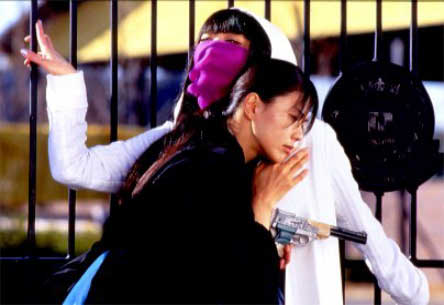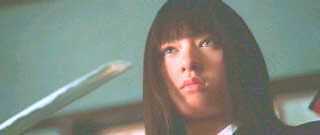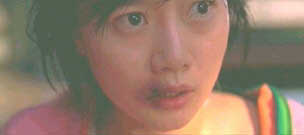Beautiful Blood on Your
Lip
Successors to GWG

Whatever Happened to Girls
with Guns?
“Shit, a dead end”
(Anita Yuen, “Enter The Eagles”)
For about ten years, from the mid-1980s until
the mid-1990s, fans of Hong Kong action cinema were rewarded with a significant
number of titles annually. These included a distinctive sub-genre
of women’s action films that might prove, with hindsight, to have also
represented the high water mark of traditional martial arts cinema.
Physical skills and acting talent have since been increasingly supplanted
by special effects and computer generated images that blur distinctions
between the possible and the fantastic.
 While the execution of such technical artistry
by auteurs of the female action genre such as Corey Yuen is occasionally
stellar, as in “So Close” (2002), other efforts may yield leaden results.
Titles such as “Naked Weapon” (2002) have digitally augmented the physical
capabilities of former models, with the predictable effect of stretching
suspended disbelief beyond breaking point. In the absence of credible
action performers or choreographers, the shift to digital augmentation
also seems to have indirectly eviscerated contemporary low budget action
films. The female characters of the action comedy “Brush Up My Sisters”
(2003), for example, are reduced to whacking their adversaries with a shovel
as the action climax – falling far short of previous benchmarks.
While the execution of such technical artistry
by auteurs of the female action genre such as Corey Yuen is occasionally
stellar, as in “So Close” (2002), other efforts may yield leaden results.
Titles such as “Naked Weapon” (2002) have digitally augmented the physical
capabilities of former models, with the predictable effect of stretching
suspended disbelief beyond breaking point. In the absence of credible
action performers or choreographers, the shift to digital augmentation
also seems to have indirectly eviscerated contemporary low budget action
films. The female characters of the action comedy “Brush Up My Sisters”
(2003), for example, are reduced to whacking their adversaries with a shovel
as the action climax – falling far short of previous benchmarks.
 The absence of credible martial skill among contemporary
performers in the relatively few HK female action films recently produced
may have the regressive effect of once again foregrounding physical appearance.
This is compounded by an apparent trend toward either saccharin antics
or favoring distinctively tall, thin former models (including Asian-Americans)
who perhaps seem to more closely approximate Western stereotypes of attractiveness
– with all their attendant problems. It is perhaps a fair comment
that such films may no longer privilege traditional Asian body types or
skills to the same degree as their “Girls With Guns” forerunners.
In the diminished HK industry of the last several years, the occasional
remaining female action film seems regressed to either parody or spectacle
– a sign that a genre may have run its course.
The absence of credible martial skill among contemporary
performers in the relatively few HK female action films recently produced
may have the regressive effect of once again foregrounding physical appearance.
This is compounded by an apparent trend toward either saccharin antics
or favoring distinctively tall, thin former models (including Asian-Americans)
who perhaps seem to more closely approximate Western stereotypes of attractiveness
– with all their attendant problems. It is perhaps a fair comment
that such films may no longer privilege traditional Asian body types or
skills to the same degree as their “Girls With Guns” forerunners.
In the diminished HK industry of the last several years, the occasional
remaining female action film seems regressed to either parody or spectacle
– a sign that a genre may have run its course.
 As the productivity and emphases of the HK film
industry have changed, so too have those of Japanese and Korean cinema.
Japanese popular culture products now generate more export revenue than
television sets. During the last few years directors new and old
have challenged the assumptions and censorship limits of Japanese cinema
with bold, violent and acidly political critiques of Japan’s consumerist
culture. Several recent Japanese action films such as Kinji Fukusaku’s
“Battle Royale” (2000) have garnered international recognition, and it
was to Japan – rather than Hong Kong – that Quentin Tarantino took his
own
variant of female action film in “Kill Bill Vol. 1” (2003).
As the productivity and emphases of the HK film
industry have changed, so too have those of Japanese and Korean cinema.
Japanese popular culture products now generate more export revenue than
television sets. During the last few years directors new and old
have challenged the assumptions and censorship limits of Japanese cinema
with bold, violent and acidly political critiques of Japan’s consumerist
culture. Several recent Japanese action films such as Kinji Fukusaku’s
“Battle Royale” (2000) have garnered international recognition, and it
was to Japan – rather than Hong Kong – that Quentin Tarantino took his
own
variant of female action film in “Kill Bill Vol. 1” (2003).
 Long burdened by ritualized generic conventions
of gender violence and pornography, recent Japanese action films have finally
begun to open a space to attack patriarchal assumptions – sometimes as
conventional narrative (e.g., “Wild Criminal,” 1999) and sometimes as surrealist
imagery (e.g., “Pistol Opera,” 2001). Although the female leads in
this new wave of Japanese action films are undoubtedly as physically beautiful
as the performers who were primarily objects of viewing pleasure in low-genre
productions such as the “Zero Woman” series, this does not appear to have
been the sole determinant of their casting. They do fight, and are
placed in physically demanding situations. Moreover, as director
Seijun Suzuki commented about his lead performer Makiko Esumi in “Pistol
Opera” (2001), “she wasn’t sexy . . . there wasn’t much I could do about
it.”
Long burdened by ritualized generic conventions
of gender violence and pornography, recent Japanese action films have finally
begun to open a space to attack patriarchal assumptions – sometimes as
conventional narrative (e.g., “Wild Criminal,” 1999) and sometimes as surrealist
imagery (e.g., “Pistol Opera,” 2001). Although the female leads in
this new wave of Japanese action films are undoubtedly as physically beautiful
as the performers who were primarily objects of viewing pleasure in low-genre
productions such as the “Zero Woman” series, this does not appear to have
been the sole determinant of their casting. They do fight, and are
placed in physically demanding situations. Moreover, as director
Seijun Suzuki commented about his lead performer Makiko Esumi in “Pistol
Opera” (2001), “she wasn’t sexy . . . there wasn’t much I could do about
it.”
 Korean films have also found increasing favor
with Western fans of Asian cinema. With the relatively recent democratization
of Korean society and furious economic development, tensions of both a
political and social nature have been natural grist for the cinematic mill.
This very conservative society in which many marriages are still formally
arranged has struggled to adjust to astonishing transformations associated
with consumerism and its attendant social developments. Within the
relatively brief time since “Shiri” (1999) alerted Western viewers to the
potential of Korean action cinema, there has been a steady stream of films
distinguished by remarkably high production values, cinematic sophistication
and a distinctively cynical view of genre conventions.
Korean films have also found increasing favor
with Western fans of Asian cinema. With the relatively recent democratization
of Korean society and furious economic development, tensions of both a
political and social nature have been natural grist for the cinematic mill.
This very conservative society in which many marriages are still formally
arranged has struggled to adjust to astonishing transformations associated
with consumerism and its attendant social developments. Within the
relatively brief time since “Shiri” (1999) alerted Western viewers to the
potential of Korean action cinema, there has been a steady stream of films
distinguished by remarkably high production values, cinematic sophistication
and a distinctively cynical view of genre conventions.
 In contemporary Korean action films, happy endings
are often as elusive as the grasp on reality of the protagonists in “A
Tale of Two Sisters” (2003). Usually taboo subjects of gender
role, homosexuality or even transgender roles find quiet expression in
the unusual settings of action comedy (e.g., “My Wife is a Gangster,” 2001),
horror (e.g., the “Whispering Corridors” series) or action (e.g., “Yellow
Hair 2,” 2001). Korean films are often intensely concerned with the
place and fate of the individual (e.g., “Sympathy for Mr. Vengeance,” 2002),
and some titles therefore inevitably engage the important social topic
of violence that involves women.
In contemporary Korean action films, happy endings
are often as elusive as the grasp on reality of the protagonists in “A
Tale of Two Sisters” (2003). Usually taboo subjects of gender
role, homosexuality or even transgender roles find quiet expression in
the unusual settings of action comedy (e.g., “My Wife is a Gangster,” 2001),
horror (e.g., the “Whispering Corridors” series) or action (e.g., “Yellow
Hair 2,” 2001). Korean films are often intensely concerned with the
place and fate of the individual (e.g., “Sympathy for Mr. Vengeance,” 2002),
and some titles therefore inevitably engage the important social topic
of violence that involves women.
 This essay attempts to identify those contemporary
Hong Kong, Japanese and Korean female action films that continue to embody
both the martial spirit and aggressively subversive stance of the “Girls
With Guns” genre films made during the heyday of HK action cinema.
It is perhaps only reasonable to expect that such films will be limited
in respect of both time and place. As essentially “liminal” or boundary-violating
works, they are perhaps most likely to be produced during times of significant
social transition.
This essay attempts to identify those contemporary
Hong Kong, Japanese and Korean female action films that continue to embody
both the martial spirit and aggressively subversive stance of the “Girls
With Guns” genre films made during the heyday of HK action cinema.
It is perhaps only reasonable to expect that such films will be limited
in respect of both time and place. As essentially “liminal” or boundary-violating
works, they are perhaps most likely to be produced during times of significant
social transition.
 It does not seem coincidental that GWG films enjoyed
prominence in HK cinema during a period of rapid social emancipation as
well as immediately preceding the relaxation of film censorship.
Similarly, Korean cinema reflects – and perhaps anticipates – tensions
within a rapidly changing society that is also emerging from political
and social controls. Contemporary Japanese cinema, too, grapples
with increasingly existential questions posed by prevailing social and
economic challenges. Japanese film also draws on manga and anime
– arenas of popular culture that aggressively examine gender. Anime,
in particular, conveys not only “kawaii” or “cuteness” but often also the
imagined exercise of power by women or girls who are generally not privileged
in this manner within patriarchal culture.
It does not seem coincidental that GWG films enjoyed
prominence in HK cinema during a period of rapid social emancipation as
well as immediately preceding the relaxation of film censorship.
Similarly, Korean cinema reflects – and perhaps anticipates – tensions
within a rapidly changing society that is also emerging from political
and social controls. Contemporary Japanese cinema, too, grapples
with increasingly existential questions posed by prevailing social and
economic challenges. Japanese film also draws on manga and anime
– arenas of popular culture that aggressively examine gender. Anime,
in particular, conveys not only “kawaii” or “cuteness” but often also the
imagined exercise of power by women or girls who are generally not privileged
in this manner within patriarchal culture.










